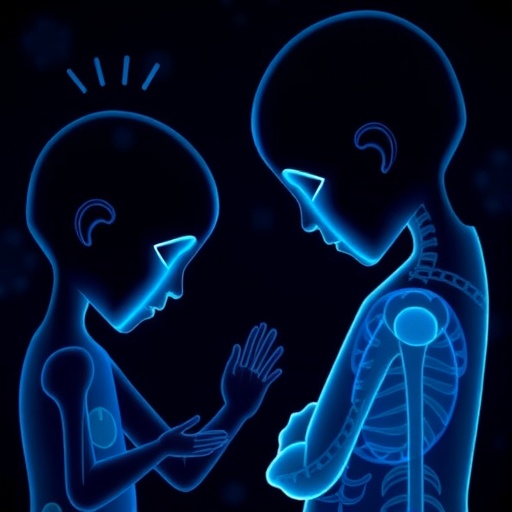In a groundbreaking study published in The Lancet Regional Health – Europe, researchers have unveiled new insights into the diagnostic journey of childhood cancers across the United Kingdom, shedding light on critical disparities and delays that persist despite advancements in healthcare access. This population-based observational study, led by Dr Sharna Shanmugavadivel and her team, represents the first comprehensive attempt to quantify the intervals and routes to diagnosis among children and young people diagnosed with cancer. The findings reveal that while ethnicity, sex, and socioeconomic status do not appear to influence diagnostic timing, significant challenges remain, particularly for teenagers and those afflicted by certain tumor types such as bone cancers.
The study meticulously analyzed the time elapsed from the initial onset of symptoms to the point of confirmed diagnosis, highlighting a striking variability ranging from diagnoses made on the same day to cases where confirmation took several years. The median diagnostic interval across all participants was identified as 4.6 weeks. However, this median varied substantially according to age cohorts and the specific cancer type, marking a crucial differential in the diagnostic landscape. Notably, adolescents aged 15 to 18 endured the longest median interval of 8.7 weeks, almost double that of infants under one year old, who experienced the shortest median time frame of just 3.7 weeks.
Among distinct cancer classifications, bone tumors emerged as the most diagnostically elusive, requiring a median of 12.6 weeks before confirmation. In stark contrast, kidney tumors were identified most rapidly, with a median diagnostic duration of merely 2.3 weeks. This pronounced lag in diagnosing bone malignancies raises concern given the aggressive progression rates and the increasing complexity of treatments required for delayed cases. The clinical implication here is profound: delayed diagnosis not only imposes heavier physical tolls on patients but also necessitates more extensive surgical intervention and intensified chemotherapy or radiotherapy regimens.
.adsslot_wqaZONuzlJ{ width:728px !important; height:90px !important; }
@media (max-width:1199px) { .adsslot_wqaZONuzlJ{ width:468px !important; height:60px !important; } }
@media (max-width:767px) { .adsslot_wqaZONuzlJ{ width:320px !important; height:50px !important; } }
ADVERTISEMENT
The investigation also explored pathways to diagnosis, noting that the majority of pediatric cancer patients interacted with healthcare services multiple times prior to receiving a confirmed diagnosis. Approximately 74% of children and young people had between one and three medical consultations preceding diagnosis, while an alarming 67% were ultimately diagnosed in emergency settings. These findings underscore the complexities inherent in early detection and the urgent need for enhanced clinical vigilance, particularly within primary care and emergency medicine contexts.
Interestingly, the study emphasized that initial consultations predominantly involved general practitioners or emergency department physicians, spotlighting the frontline healthcare providers as pivotal players in the diagnostic process. Analysis further revealed that certain cancer types — including Langerhans Cell Histiocytosis (LCH), bone tumors, soft tissue tumors, and brain tumors — were associated with a higher frequency of medical visits before diagnosis. This suggests that symptom ambiguity or presentation variability in these cancers contributes to diagnostic delays and increased patient burden.
Despite the equitable access to diagnostic services across demographic groups, the study stresses the persistent gap for specific populations. Teenagers face longer intervals potentially due to a combination of physiological, social, and healthcare system factors that complicate symptom recognition and prompt action. The infectio of age-related biological characteristics and healthcare engagement challenges is an area demanding further research and targeted intervention.
Complementing this, the Child Cancer Smart campaign, led by CCLG (Children & Young People’s Cancer Association), plans to integrate these findings into its awareness and education efforts. By empowering healthcare professionals and educating the public about early signs and symptoms, the campaign aspires to pave the way for swifter diagnoses and, consequently, enhanced survival rates among children and young people with cancer.
Ashley Ball-Gamble, CEO of CCLG and co-author of the study, underscores the universality of childhood cancer as a health challenge that transcends socio-economic and ethnic boundaries. More importantly, she emphasizes the study’s pivotal role in illuminating the nuanced differences in diagnostic intervals for particular age groups and cancer types. This knowledge is crucial for tailoring interventions and ensuring equitable improvements across diverse patient profiles.
Professionally, Dr Shanmugavadivel’s recent appointment as Vice-Chair of the Children and Young People Taskforce underscores her influential role in shaping pediatric oncology strategies at a national level. The taskforce’s expert panel collaborates to design comprehensive approaches that encompass treatment improvements, diagnostic precision, and research direction aligned with the National Cancer Plan. Her stewardship promises to steer data-driven policy reforms informed by empirical evidence such as that presented in this study.
These novel findings not only highlight the urgency of diagnosing childhood cancers at the earliest possible stage but also call attention to the need for systemic changes in healthcare pathways, especially for vulnerable groups. By reducing diagnostic intervals, healthcare systems can potentially diminish tumor progression rates, limit invasive surgeries, and increase the efficacy of therapeutic interventions, collectively enhancing survival outcomes and quality of life for children and young people affected by cancer.
This research further opens avenues for innovative clinical training modules, diagnostic algorithms, and awareness programs that could be deployed at various healthcare touchpoints. The intricate patterns uncovered by this study reinforce the critical role of front-line providers in recognizing subtle symptomatology and initiating timely referrals—a factor vital to bridging the existing gaps in pediatric cancer care.
In summary, the Childhood Cancer Diagnosis (CCD) study presents an essential lens through which the complexities of cancer diagnosis in the UK’s younger populations are understood with unprecedented detail. Its revelations are set to influence national policies, clinical practice, and community education efforts, driving a future where every child and young person receives a prompt and accurate cancer diagnosis devoid of demographic disparities. Ultimately, this work not only represents a scientific milestone but also a beacon of hope for families and healthcare providers alike, striving for better outcomes in one of medicine’s most challenging arenas.
Subject of Research: People
Article Title: Quantifying diagnostic intervals and routes to diagnosis for children and young people with cancer in the UK (Childhood Cancer Diagnosis study, CCD): A population-based observational study
News Publication Date: 27-May-2025
Web References: http://dx.doi.org/10.1016/j.Janepe.2025.101329
Keywords: Cancer, childhood cancer, pediatric oncology, diagnostic intervals, bone tumors, brain tumors, Langerhans Cell Histiocytosis, healthcare access, emergency diagnosis, adolescent health
Tags: bone cancer diagnostic challengeschildhood cancer diagnostic journeydelays in cancer diagnosis for childrendiagnostic intervals for pediatric cancersdisparities in cancer diagnosisethnicity and cancer diagnosishealthcare access and cancer diagnosismedian diagnostic interval for childhood cancersobservational study on pediatric cancerresearch on childhood cancer delayssocioeconomic factors in cancer diagnosisteenagers and cancer diagnosis





